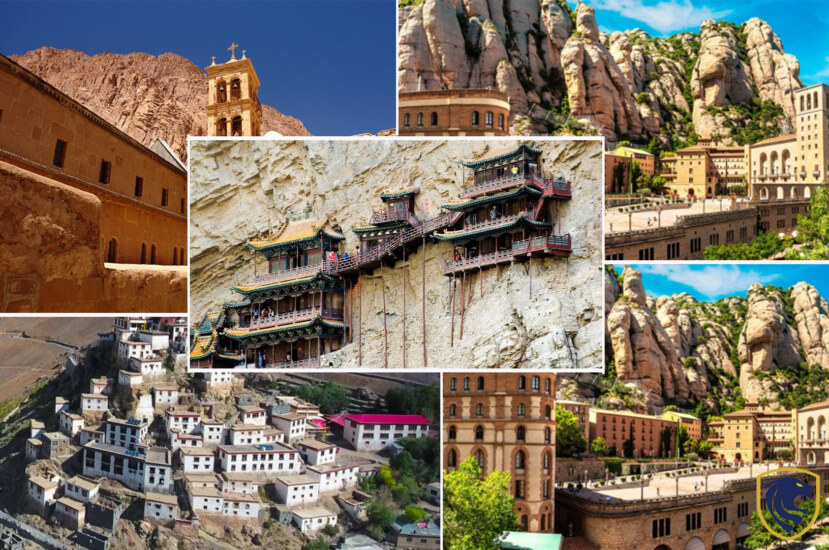Santuario Madonna della Corona Monastery -Italy
A monastery in northern Italy called Santuario Madonna della Corona is built on a cliffside in Spiazzi, close to Lake Garda. The shrine has long been a destination for pilgrims seeking to combine prayer and tranquility. It is perfect for that because of its idyllic setting amidst the hills and mountains of Italy. Moreover, For several hundred years, monks resorted to the Santuario to find serenity. Most of the Santuario as it is known today was built on the foundation of the church that had been renovated by a later building in the middle of the 1600s.
A winding track that is largely accessible on foot. But it may be reached by bus up to a point that leads to Santuarioaurio. Visitors may observe monuments that represent the stations of the cross along the trail. Moreover, there are other sculptures within and outside the church itself at the Sanctuary. Although it has decayed somewhat, the church survived until the 20th century. Its relative inaccessibility prevented it from being completely demolished or desecrated. An Italian architect managed to rebuild most of the dilapidated building in 1970. Moreover, he was able to preserve as many significant aesthetic flourishes as possible.

Santuario Madonna della Corona Monastery -Italy ;Must Visit Monasteries Around The World.
The mountain route to the chapel has been built safer today. Also, the extraordinary church is still a famous pilgrimage site among travelers and pilgrims. Further, you can witness the Scala Santa, an exact recreation of the stairs Jesus ascended to Pilate’s castle before he was sentenced to death on the cross in this monastery. Although there aren’t any monks living here anymore, it’s well worth the journey. So, if you’re ever in northern Italy’s Verona region visit the Santuario Madonna della Corona Monastery.
Ki Gompa, Spiti Valley-Himachal Pradesh
This is the biggest gompa in the Spiti Valley, situated in the little settlement of Ki and perched on a 4116 m hill. It is the monastery and center of learning for Tibetan Buddhist scriptures. There are over 300 monks living here. As a habit, they begin their daily rituals and study at 7 AM. Both the Zimshung Lhakhang and the medieval prayer halls are offered to tourists upon request. Every year, at the Ki Chaam Festival (June–July) and Losar, ceremonial masks are displayed.
The beautiful monastery is home to 250–300 Lamas or spiritual leaders in Tibetan Buddhism. Also, it is maintained by a Gelug sect of Tibetan Buddhist monks as a fully operational religious training facility for Lamas. You will be mesmerized by the old monastery’s stunning architecture, which has a fantasy-fiction feel to it.

Ki Gompa, Spiti Valley-Himachal Pradesh
The monastery is visited by millions of believers and visitors from all over the world who come here to seek Buddhism. It is surrounded by stunning snow-capped Mountains and glaciers. You will have a wonderful experience thanks to the monastery’s beautiful setting. Also, lovely villages blanketed in snow and long and winding roads draw a bewitching picture.
Santa Maria de Montserrat Abbey-Spain
This monastery was erected around the monument of the Black Madonna, a revered figure on Montserrat in the ninth century. It’s a fantastic day trip that you must visit from Barcelona. Moreover, the fact that this sacred place is situated in the Montserrat mountains sets another plus point. These mountains got their name from the way they resembled serrated blades. You can take the gondola or railcar up the mountain. When you visit the monastery, the basilica does not forget to wear your long pants.

Santa Maria de Montserrat Abbey-Spain ;Must Visit Monasteries Around The World.
The art and archaeology museum will certainly fascinate you. In addition, you can pay a visit to the outdoor market. Don’t forget to buy their signature local goat cheese. You should wait in line to touch the orb on the statue of the Black Virgin Mary. Montserrat’s mountaintop site, which was constructed around the immovable statue, is exceptional. But some find it to be somewhat mysterious as it looks to be a part of the mountain itself.
Hanging Monastery-China
During the Northern Wei Dynasty, a monk by the name of Liao Ran is said to have constructed the Hanging Temple.
A wooden frame supports the whole unique temple building. It was built by bored holes which are up to 2-3 meters deep into the cliffside. In addition, they have put beams inside of them. On this horizontal base, the pavilions were constructed.

Hanging Monastery-China
This jaw-dropping structure appears to be supported by several pillars today. But in reality, the wooden pillars were added later for safety and preservation after the temple had already been built.
Saint Catherine’s Monastery-Egypt
In the Egyptian city of St. Catherine, the Greek Orthodox St. Catherine’s Monastery is located at the base of Mount Sinai. It was constructed in the sixth century and has been continuously in use ever since. That makes it one of the oldest monasteries in the whole world. According to the legend, the Burning Bush’s roots were used to build the altar that sits atop the Byzantine chapel inside.

Saint Catherine’s Monastery-Egypt ;Must Visit Monasteries Around The World.
In addition, the monastery’s library is a notable feature. which is also from the sixth century and has more and more valuable manuscripts than the Vatican collection. The monastery museum allows visitors to have a glimpse of the library’s magnificence. But now it is digitalized to protect against natural calamities.
Sveti Marija Benedictine Monastery-Croatia
It was founded in 1151 on a little island within Mljet National Park by a small group of Benedictine monks who crossed the Adriatic from Italy. It is not only one of Croatia’s most stunning monasteries but is recognized around the world. The monastery is still in operation today. So, when you visit, it’s not unusual to hear singing emanating from the church.
The history of this lovely monastery is intriguing. First of all, it was constructed on an island in the center of a lake that makes up Mljet National Park. These two lakes used to be fresh water and weren’t linked to the ocean.

Sveti Marija Benedictine Monastery-Croatia ;Must Visit Monasteries Around The World.
Yet the monks back then were wise! To strengthen the tide, monks who lived in the monastery built a channel between the lake and the ocean. They chose the place where the soil was the thinnest to make this channel. The lakes now are saltwater and flow with the shifting ocean tide.
During the plague of the fourteenth century, the monks used the Benedictine monastery’s island position as a site of quarantine. The monks served as pharmacists during this period. They did a great service in assisting people during the Black Plague.
You may stroll through the meadows and gardens and perhaps have coffee at the island’s little café. It’s one of the most tranquil places to visit in Croatia. Also, many people kayak and ride bikes in the surroundings.




